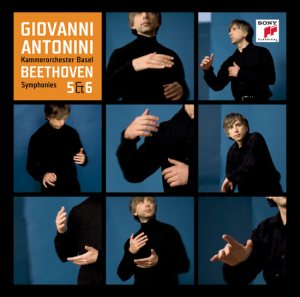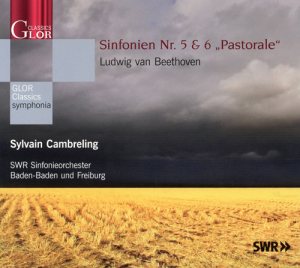 |
 |
|


alternatively
CD: MDT
AmazonUK
AmazonUS
|
RECORDING OF THE MONTH
Ludwig van BEETHOVEN (1770
- 1827)
Symphony No. 5 in C minor, op. 67 (1808)1 [30:21]
Symphony No. 6 in F major, op. 68, Pastoral (1808)2
[39:12]
 Kammerorchester Basel/Giovanni Antonini
Kammerorchester Basel/Giovanni Antonini
rec Kultur- und Kongresszentrum Lucerne, 1
8-9 July 2008, 2 3-5 July 2009, DDD
 SONY MUSIC 88697648162 [69:33]
SONY MUSIC 88697648162 [69:33]
|
|


alternatively
CD: MDT
AmazonUK
AmazonUS
|
Ludwig van BEETHOVEN (1770
- 1827)
Symphony No. 5 in C minor, op. 67 (1808)1 [31:14]
Symphony No. 6 in F major, op. 68, Pastoral (1808)2
[39:52]
 SWR Sinfonieorchester Baden-Baden und Freiburg/Sylvain Cambreling
SWR Sinfonieorchester Baden-Baden und Freiburg/Sylvain Cambreling
Rec. 1 Freiburg,Konzerthaus 29 November 2003;
2 Essen, Philharmonie & Basel,
Stadtcasino, 23-24 January 2007, DDD
 GLOR CLASSICS GC11461 [71:24]
GLOR CLASSICS GC11461 [71:24]
|
|
|
The two recordings being reviewed here offer the contrast of
Sylvain Cambreling’s full orchestra and Giovanni Antonini’s
chamber orchestra. Does it matter? We shall see.
In Symphony 5 Cambreling gives us a fiery dragon of an
opening movement with a stern, dour treatment of the four-note
motto. There are explosive tuttis and a stark, mysterious
and troubled development (tr. 1 2:47). Notable is the sole protesting
voice in the poignant oboe cadenza, suddenly and rarely free
from the forward thrust of the rest of the movement before the
relentless and turbulent coda. Antonini steps back a little,
offering less weighty sonority but equally impactful brass bite.
There’s also a wider and more telling dynamic contrast,
for example in the transition (tr. 1 0:43) from very loud horns
to soft, sweet first violins, then clarinet, then flute. The
focus of his development is deftness and surprise: when you
think the trouble has quelled it breaks out again. The oboe
cadenza here is less rhetorical, more puzzled questioning. The
coda is defiant but there’s also something of pride, even
celebration in this.
Cambreling begins the slow movement (tr. 2) with nonchalantly
flowing smooth strings and then a nicely nuanced woodwind response.
When the second theme moves from very soft (0:49) to very loud
(1:03) the belching dragon has returned throwing his weight
around and I find this rather hectoring. By contrast the variation
with the theme in demisemiquavers is very deftly done. Antonini
has a more genial opening to this movement and his giving the
second theme a sense of triumph, exultant but not fiery, I find
more convincing than Cambreling’s treatment. Antonini’s
gradual rise in dynamic of the following very soft strings’
passage is also more mysterious than Cambreling while he makes
the theme in demisemiquavers (tr. 2 3:20) more gentle but flowing.
From the very loud horns early in the Scherzo Cambreling proves
to be more triumphant, more of an anticipation of the finale,
than fierce, though there’s a haunted feel that things
could go wrong. The Trio, that famous dexterity required of
cellos and basses (tr.3 1:38) is sturdy and the following splashes
of pizzicato when the Scherzo returns playful and quizzical.
Antonini, beginning with greater dynamic contrast, has more
sense of mystery in the softer passages and sheer bite to the
horns. His Trio is lighter in articulation, more athletic. The
return of the Scherzo has a disturbingly distilled quality:
you appreciate its focus but feel it might evaporate any moment.
Cambreling’s drum solo ushering in the finale is ominous,
propelled into a weighty and sonorous closing movement with
at times thunderous timpani. Cambreling goes out in a blaze
of glory and still points details well, though his pace obscures
total clarity in the piccolo’s articulation of its rising
flourishes. Antonini finds more warmth in his drum solo, more
sense of expectation. It’s good to hear the piccolo clearly
from the opening tutti and crisper in articulation in
its late solos. Here’s a finale of great conviction in
its leaner sound yet also more muscular rhythmic life.
With the Pastoral symphony the question is how well are
conveyed Beethoven’s ‘Pleasant, cheerful sensations
awakened on arrival in the countryside’? Cambreling does
this by adopting a fast tempo, for which Beethoven asks, on
the very edge of ‘but not too fast’, which Beethoven
warns against. Cambreling gets away with this because of light
articulation and dexterous playing. So the joyful first tutti
has eagerness and bounce which lends excitement to the flutes’
flourishes. The second theme (tr. 5 1:06) has a light glint
leading to sunny loud affirmation by the upper strings. In the
development from 4:39 there’s a gradual crescendo
just as marked to a thrilling fortissimo and a confident,
vigorous tutti come the recapitulation. Antonini is a
touch more leisurely and you appreciate more the vertical density
of the score, if at a little cost to the horizontal progression.
On the other hand he’s then able to provide a more contrasted,
dainty second theme (tr. 5 1:09). There isn’t the sheer
flow Cambreling provides but this does give Antonini scope for
more emphasis on rhythmic impetus, making his crescendo
in the development (from 4:52) more brooding and urgent. Its
termination in the unleashing of the fortissimo seethes
more effectively.
In the ‘Scene by the brook’ the question is how
fast is it flowing? Beethoven’s marking is Andante
molto moto quite fast and so is Cambreling who gives us
a sultry, benign flow with glowing woodwind. It’s beautifully
played but a bit abstract. Antonini, just a touch slower, has
something more magical, a sublime sense of summer indolence.
This is achieved through shaping of the lines, a more sensitive
dynamic shading and a more melting approach from the woodwind.
The end result is a feeling of beneficence.
The ‘Merry gathering of the country people’ is very
nifty and blithe in Cambreling’s hands but the country
band are virtuosi. A vigorous Country Dance lets in a distinctly
earthy element. Antonini, only slightly slower, conveys more
of bustle and a certain abandon. There’s a potential fragility
about the band solos that makes them more engaging. The Country
Dance is less rustic but it’s still lively and full of
momentum. For ‘Thunder. Storm’ Cambreling brings
a creepily arriving pattering of rain. Then comes a timpani
thunderbolt that could knock you out of your seat. The timpani’s
contribution is tremendous throughout this movement. Antonini
reveals both rain and thunder cleanly with both starkness and
density though without Cambreling’s impact.
To the ‘Shepherds’ Song: Beneficent feelings bound
with thanks to the Godhead after the storm’. Cambreling
brings a smooth, cantabile gratitude through a lovely
slender first violins’ tone and fine balance between strings,
woodwind and brass. There’s also a clear and satisfying
transfer of the song when present in running semiquavers from
first violins (tr. 9 3:56) to second violins (4:11) to violas
and cellos (4:27). The climax (7:25) opens thrillingly enough
but its peak (7:41) is a touch formal and remote. Antonini’s
emphasis on projection of rhythms brings more of a feel of spontaneity.
The transfer of the song here (at 3:34, 3:50 and 4:04 respectively)
is more fleetly and delicately done than Cambreling but Antonini
also brings more vibrant contrast. His louder passages are a
more joyous celebration, the climax (6:41) and its peak (6:56)
more shaped.
Michael Greenhalgh
Masterwork Index: Symphony
5 ~~ Symphony
6
|
|

